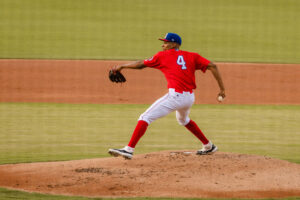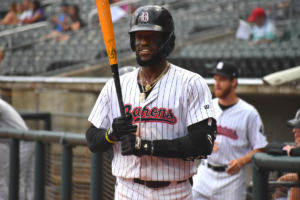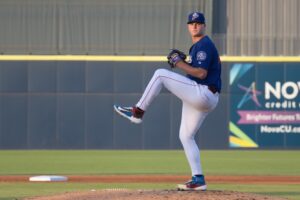2020 Pre-Season: Top White Sox Prospects by Position – Starting Pitching
This is the first entry in our second annual off-season article series here at FutureSox separate from our twice annual top 30 White Sox’s prospects list. We list the top five or 10 minor leaguers in the White Sox’s system at each position on the field.
Similar to the editions on outfielders and middle infielders, this list ranks the top ten starting pitchers in the White Sox system. With the top eight players on this list all included on the overall top 30 prospect list from mid-season 2019, this is one of the strongest position groups currently in the system.
1. Michael Kopech-Ranked 2nd overall, last level majors
Rick Hahn made a franchise-defining trade to acquire Michael Kopech from the Boston Red Sox. On top of Kopech, the White Sox received then top-ranked prospect Yoan Moncada, switch-hitting outfielder Luis Alexander Basabe and reliever Victor Diaz in exchange for Chris Sale.
The 2016 trade unofficially signified the White Sox commitment to a rebuild. Kopech was making a beeline to 35th and Shields in 2018 after a successful first stint in the Sox’s system across 2017.
Kopech made his Major League debut on a rainy August 21st evening against the Minnesota Twins. He proceeded to appear in three more outings before needing Tommy John surgery.
The soon-to-be 24-year-old missed all of 2019, but several reports indicate his rehab process was successful. The question remains whether he will begin 2020 in Charlotte or with the White Sox.
Kopech’s arsenal is built around the fastball, which he will go triple digits with, but sits comfortably in the 95-99 MPH range. Despite the outstanding velocity, Kopech features a delivery with no major mechanical red flags to speak of.
Beyond the fastball, Kopech features two raw but promising secondary pitches that project plus. He throws an 86-90 MPH slider that has sharp break that he can throw for strikes or bury, especially effective against left-handed batters.
Kopech’s third offering is a 91-93 MPH change-up that he has shown a solid feel for and is devastating for hitters expecting the triple digits fastball. He also mixes in a 2-seam fastball in the low 90’s to challenge timing with some arm-side run. In AAA, he even added back a curveball from his high school days. Below is his first Major League strikeout.
2. Dane Dunning-Ranked 6th overall, last level AA
Dane Dunning was among the return of Reynaldo Lopez and Lucas Giolito in the trade that sent Adam Eaton to the Nationals in December of 2016. Dunning made 26 starts across Kannapolis and Winston-Salem in 2017, but dealt with an elbow issue midway through 2018.
The White Sox shut him down on June 27 and monitored the elbow injury that, at the time, they believed did not require surgery. After a rehab process in the offseason leading into 2019, Dunning suffered a setback and was effectively done for the year after undergoing Tommy John surgery in March.
The right-hander will enter his age 25 season in 2020 with a career 2.74 ERA over 266 Minor League innings, with Double-A Birmingham acting as his highest level of competition. Dunning boasts a career 10.2 K/9 ratio thanks to 300 strikeouts compared to 71 walks.
He sits 92-93 MPH, but can run it up to 95 on occasion with good downhill plane. While trade package partners Giolito and Lopez feature plus curveballs for their secondary offering, Dunning’s best breaking ball has generally been an above average mid-80’s slider that has good break and tilt.
Dunning’s third pitch is a below average change-up that he rarely used as a reliever but has been working on as a starter. That curveball has made a return to his repertoire as well, specifically a spike variety, and it was showing promise in 2018.
Dunning was protected prior to this year’s Rule 5 draft. The 6-4, 200-pounder projects to return around May or June in 2020 and can effectively make an impact on the White Sox big-league club come 2021.
3. Jonathan Stiever-Ranked 9th overall, last level A+
Jonathan Stiever took a major leap in 2019 thanks to a successful adjustment in Advanced-A Winston-Salem. In his first full professional season, Stiever was promoted to the Dash on June 20 and never looked back.
In 12 Carolina League outings, Stiever boasted 10 quality starts. In the two outliers, he combined to allow three earned runs on nine hits with 12 strikeouts and two walks over eight innings. The 5th round pick of 2018 finished his first stint in Advanced-A with a 2.15 ERA, 0.97 WHIP, struck out 77 compared to 13 walks and allowed just 56 hits across 71 innings pitched.
Clinton Cole talked to Stiever in August last year and shared he worked with Matt Zaleski in Winston-Salem and learned how to prevent his fastball from leaking over the plate all while working in his devastating breaking ball more frequently. “Sequencing my pitches better has led to a lot more success and, in turn, more swing and misses,” Stiever said.
The right-hander was evaluated to have a 60-grade fastball in the 91-96 mile-per-hour range. Our July Brady covered a plethora of Stiever starts in Winston-Salem and noted he sat 95-96 in the first inning while also touching 98 in his debut.
Home plate view of Stiever’s mechanics:
Another Stiever strikeout:
Stiever is largely considered a breakout candidate in 2020 among us at FutureSox. Turning 23-years-old in May, it wouldn’t be out of the question to see him in Charlotte by year’s end.
4. Matthew Thompson-Ranked 15th overall, last level Lo-RK
Matthew Thompson is one of two high school right-handed arms the White Sox selected in the early rounds of 2019. He threw twice in the Arizona League and allowed two hits, an unearned run and struck out two.
The White Sox selected Thompson 45th overall largely because of his build, his mid-90’s fastball and his sharp repertoire that features a tight low-80’s slider, a deceptive sinking changeup and a 55-grade curveball, according to MLB Pipeline.
Entering his first full professional season, the 6-3, 195-pound righty will likely be monitored by the White Sox in Arizona throughout the early part of 2020 but could start the season with Kannapolis depending on the spring. For more information on Thompson, read James Fox’s feature from June HERE.
5. Andrew Dalquist-Ranked 13th overall, last level Lo-RK
The White Sox went back-to-back high school right-handers in the 2019 draft in the second and third rounds. Andrew Dalquist was selected 81st overall with an over-slot bonus of $2 million.
This from MLB Pipeline:
Dalquist now operates at 91-93 mph and reaches 95 with the promise of more velocity to come. He uses four-seamers up in the strike zone and two-seamers down at the bottom, with his extension creating deception that stands out more than the life on his heater. He gets good depth on his mid-70s curveball, which should become a consistently solid offering once he adds some more power. Dalquist also has a slider and changeup that he hasn’t used much. He’s athletic and has a whippy arm action that allows him to throw strikes. He still has room to add a lot more strength to his skinny 6-foot-2 frame, so he should continue to gain velocity.
Our Sean Williams wrote a feature on Dalquist, highlighting his approach to professional ball and the draft process. The White Sox took it easy on the high school arm in his first season. Dalquist allowed two hits, two walks and two strikeouts over three innings pitched in the Arizona League.
He’s in a similar position roster wise to his draft mate Thompson. Dalquist is a player I will be paying close attention to in 2020.
6. Jimmy Lambert-Ranked 20th overall, last level AA
Jimmy Lambert earned spot No. 20 in our 2019 midseason top-30 rankings of White Sox prospects. He comes in as the sixth best prospect among starting pitchers.
Lambert was a 5th round draft pick in 2016 out of California State University Fresno and has thrown 342.2 innings across four Minor League seasons. He was assigned to Double-A Birmingham to begin 2019, but was put on the shelf in June due to Tommy John surgery.
The 25-year-old right-hander saw major changes in his stuff thanks to an offseason of bulking prior to 2018. That year, Lambert increased his K/9 from 6.1 to 10.3. Our Rob Young provided a feature on Lambert in July of 2018, noting: “Generously listed out of college at 6’2 and 170 pounds, Lambert added 15 pounds of muscle this off-season and has bumped his fastball velocity from 88-91 MPH in previous seasons to sitting 92-94 and topping out at 96 this year.”
Injuries eluded Lambert throughout his collegiate career, as the workhorse accumulated 229.1 innings over three years as a starter. In 2016, Lambert threw 97.2 innings at Fresno State and later logged another 37.2 in the Sox system that same year.
The White Sox will monitor Lambert’s return from major elbow surgery, but with the widespread trend of healthy returns from Tommy John, it is reasonable to believe the right-hander will see time in Charlotte in 2020. Lambert was added to the 40-man roster this offseason to be protected from the Rule 5 draft.
7. Konnor Pilkington-Ranked 18th overall, last level A+
Konnor Pilkington earned White Sox Minor League Pitcher of the Month in April while he was still with Kannapolis. Shortly thereafter, he jumped to the next level. A third round pick out of Mississippi State in 2018, Pilkington exceeded expectations after earning a promotion just 33.1 innings into his first full professional season.
He was challenged in Winston-Salem, but he held his own to the tune of a 3.61 FIP in 95.2 innings. In total, the 21-year-old accumulated 129 innings, which is the most encouraging sign of all.
Kannapolis Cannon Ballers broadcaster Trevor Wilt said this of Pilkington: “He’s got a backdoor, slow breaking curveball that is absolutely insane. He pounds that outside edge and doesn’t stop. His fastball is only about 92-miles-per-hour, but his changeup is what makes that fastball look so dirty and that’s been one of his go-to pitches.”
“He’s a massive competitor,” Trevor went on to say about Pilkington. “He works insanely quick. He doesn’t mess around. He throws a pitch – his glove is already up in the air waiting for the ball to come back from the catcher.”
Ultimately, the young left-hander compiled a 4.99 ERA in the Carolina League, good for a 4.12 total ERA across 2019.
8. Bernardo Flores-Ranked 21st overall, last level AA
Bernardo Flores comes in at eight on our list of top starting pitching prospects in the Sox system. Flores will enter his fifth season following his 2016 7th round draft selection.
The White Sox protected the 6-2, 190-pound left-hander from this year’s Rule 5 draft by adding him to the 40-man roster. Flores had a truncated 2019 after an oblique injury forced him to miss all of June and early July.
Aside from five rehab appearances in Kannapolis and the Arizona League White Sox, Flores completed the year with a 3.33 ERA and 1.14 WHIP across 15 starts and 78.1 Double-A innings. He also pitched in the Arizona Fall League this season, but struggled to the tune of a 7.97 ERA over six starts.
Below is a video I took of Flores going through his warmups in a Minor League spring training contest.
Left-handed pitchers who get guys out will play in the Big Leagues. Flores is in a prime position at this point in his career to force his way to Rick Hahn’s front step at Guaranteed Rate Field.
9. Kade McClure-Unranked, last level A+
Kade McClure was a 6th round draft pick in 2017 out of the University of Louisville. After making eight starts across his first professional season in Kannapolis, McClure suffered a ligament tear in his left knee that cost him all of 2018.
McClure said to Clinton Cole in an interview that his rehab process was rigorous. He also mentioned his knee will be something he will need to account for throughout his career. McClure stands at 6-7, 230-pounds, so the stability of that knee is crucial in his plant leg.
He was healthy to start 2019. The 23-year-old right-hander made 10 starts in Low-A before his promotion to Winston-Salem. Proving the surgically repaired knee was a non-factor, McClure started 12 more times in Advanced-A and finished with a combined 3.25 ERA in 121.2 innings.
“I think this year has been a huge jump,” McClure said in June last year. “I’ve added a curveball. I’ve tried to sharpen up my slider and my changeup has come a long way. It’s a pitch that, in the past, I haven’t been comfortable to throw in every situation as to this year where if it’s called I’m throwing it.”
Below is a video of McClure’s mechanics in an April start of 2018.
Here is a strikeout by McClure from that same game:
McClure got stronger as 2019 went on. After stumbling a bit out of the gate, the tall right-hander pitched into the sixth inning in eight of his 12 starts in Winston-Salem. He went on to walk only 29 in just over 100 innings, but his strikeout rate remains under one-per-nine innings. With the latest technology at the White Sox disposal, McClure is hoping to make that most of his stuff.
A lot of the new metrics that we’re getting to look allows us to get information that I maybe wouldn’t have known in the past or even coaches wouldn’t know just with their own eyes. It’s just stuff you can’t see unless it’s on a camera or some kind of tracking system we can use to our advantage. I’m someone who has higher spin rate, which creates that backspin and rise on the ball. My job is to live up in the zone a little more and that’s helped me. I’ve been trying to pitch in the upper corners of the zone as opposed to down at the knees. That kind of compliments the ability to throw a curveball with depth and stuff like that. It’s nice to hear this new information and put it to use.
Kade McClure to Clinton Cole
This is another player I will be personally paying close attention to in 2020.
10. Taylor Varnell-Unranked, last level A+
Taylor Varnell earns a top-10 ranking following a strong first full season as a professional. Varnell was drafted in the 29th round of 2018 out of Oral Roberts University and is entering his age 25 season. He was forced to redshirt one season in college due to a labrum and rotator cuff tear.
Our Ken Sawilchik talked to Varnell in May last year and Ken mentioned the left-hander works with a low-90’s fastball accompanied with a slider, a changeup and a knee-buckling curve.
“The curveball may not be my best pitch, but it’s my favorite pitch,” Varnell said. “I grew up watching Barry Zito and he had this big curveball; I tried to replicate it.”
Varnell worked his looping curveball into a repertoire that accumulated a 3.25 ERA and 3.09 strikeout-to-walk ratio in 127.1 innings across Low-A Kannapolis and Advanced-A Winston-Salem. Spending the majority of his season with who are now called the Cannon Ballers, the 6-1, 190-pound lefty struck out 115, walked just 34 and allowed 86 hits in 106 innings. Varnell also tossed at least six innings in half of his 20 starts prior to his promotion to the Dash.
His WHIP finished at 1.18 after he allowed just under a hit per inning and 10 walks over four starts and 21.1 frames in the Carolina League.
“The kid just pounds the zone,” Cannon Ballers broadcaster Trevor Wilt said of Varnell. “I was tracking how many batters he started off with a strike. I stopped counting because it was almost every single batter. The cool thing was it wasn’t just his fastball he was throwing for a strike first pitch. It was his slider, his change-up and his curveball. He’s got some really good stuff, and he’s not afraid to use it any time throughout the at-bat.”
“Once I get ahead right now, I feel really confident in all four of my pitches: my change-up, my slider,” Varnell said. “I feel like I can throw that any time. I’ve been locating the fastball really well. I can put it where I want on either side of the plate.”
A key for Varnell and the White Sox in 2019 was his durability. Throwing over 120 innings in a pitcher’s first full professional season is notable. Varnell’s timeline in 2020 will be determined by how well he adjusts his command to a more experienced level of competition. His pathway to Birmingham will be a storyline to keep an eye on all year.
HONORABLE MENTIONS
Ronaldo Guzman turns 17-years-old in August of 2020 and spent last season in the Dominican Summer League and is an honorable mention on this list. The 6-0, 150-pound left-hander sported a 4.53 ERA in 14 games (12 starts) across 51.2 innings. Guzman’s encouraging 2019 was highlighted by his 76 strikeouts compared to 29 walks. Ben Badler of Baseball America said this to FutureSox in an interview regarding the lefty:
Guzman is a good example of an under-the-radar type arm that looked pretty good right away. In his case, I think it’s more about pitchability – feel for pitching – than raw stuff; or at least raw fastball. He’s right around 90 mph. It’s not overpowering. You need to hope more velocity comes with him, which it certainly could. He’s young. He’s got time to develop it. Sometimes it comes, sometimes it doesn’t. Sometimes you’re just guessing to a certain extent. He’s got good feel for pitching and he’s got some feel for his offspeed stuff, too. Pretty advanced changeup for his age and he’s got pretty good feel for spinning a breaking ball. In his case, you have to be encouraged so far and hope more velocity comes around as he develops.”
Ben Badler on Ronaldo Guzman to FutureSox
OTHERS: Lincoln Henzman, Avery Weems
Want to know right away when we publish a new article? Type your email address in the box on the right-side bar (or at the bottom, if on a mobile device) and click the “Subscribe” button. Our list is completely spam free, and you can opt out at any time. Also, consider supporting FutureSox on Patreon! You can get early access to special articles and Patreon-only posts, in addition to more benefits you can read about here.






